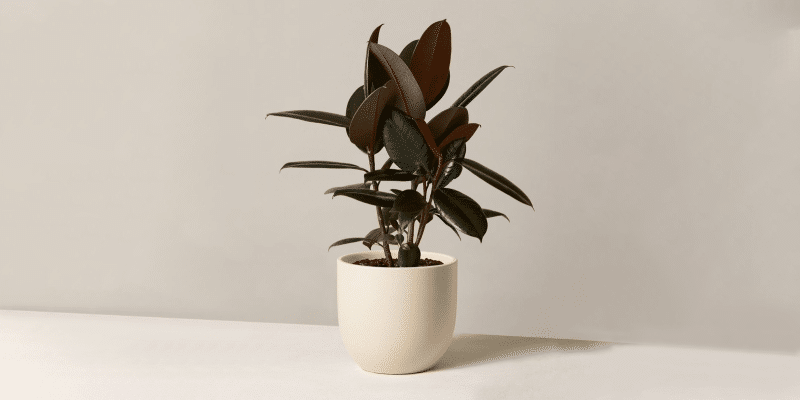If you’re looking to add some greenery to your indoor space, the Ficus elastica, also known as the Rubber Plant, is a classic and iconic choice.
In this article, we’ll explore the Rubber Tree, its historical lore, and provide you with our years of experience growing this plant (and often nursing it back to health).
You’ll learn how to care of your Rubber Plant, including tips on pruning, propagating, and the most common issues we see.
Plus, we’ll delve into the history and varieties available for this plant, so you can choose the perfect one for your home.
Table of Contents
Ficus Elastica Care Guide
History, habitat, and characteristics
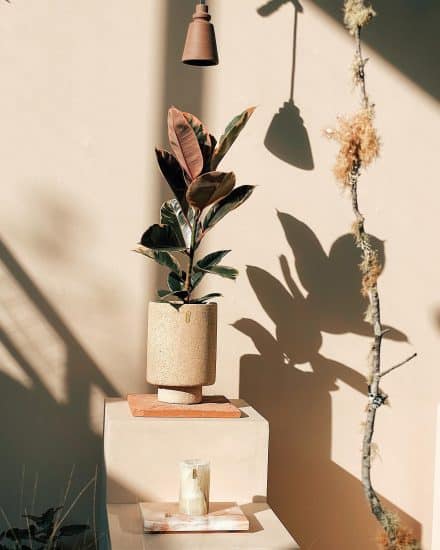
Ficus elastica (Rubber Plant), is one of the most iconic indoor houseplants around. For many, the rubber tree plant may be the first indoor plant they own, or often what they remember having as a child as they grew up.
Ficus elastica, a member of the Moraceae family, is native to tropical regions in South East Asia, such as India, Taiwan, Malaysia, and Indonesia, where it can grow over 100 feet tall in its natural habitat.
Indoors, they often stretch up to the ceiling when taken care of and not pruned back. They’re well known for their milky white latex sap, which has been cultivated for thousands of years and is an integral part of traditional Ayurvedic medicine.
This same sap can cause allergies in people who are allergic to latex, so be careful with handling, especially while pruning. Even to those without allergies, this sap can be irritating, so make sure to wash it off with soapy water.
As these plants grow pretty quickly indoors, pruning will be something you become accustomed to, unless you plan on building an extension or letting it brush the ceiling.
So while you might remember how this tropical plant once looked (and smelled!) from childhood, a lot has changed in the past ten years as it has surged back to popularity.
New rubber plant cultivars have been created and discovered, and the number of rubber trees and looks available has expanded pretty dramatically.
Rubber plant varieties
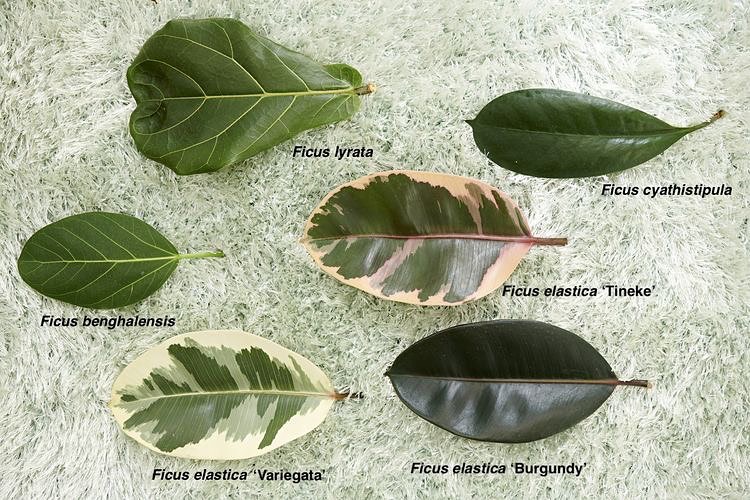
We’re going to cover four of the most popular Rubber plant varieties:
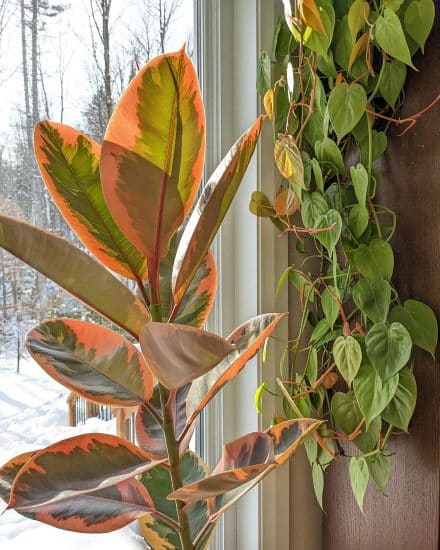
Ficus elastica ‘Ruby’ – Similar to Abidjan, this variety differs primarily in color. Also known as the variegated Rubber plant, its leaves range from deep greens that border on black to splashes of bright pink, mainly around the outside of the leaves and through the midrib.
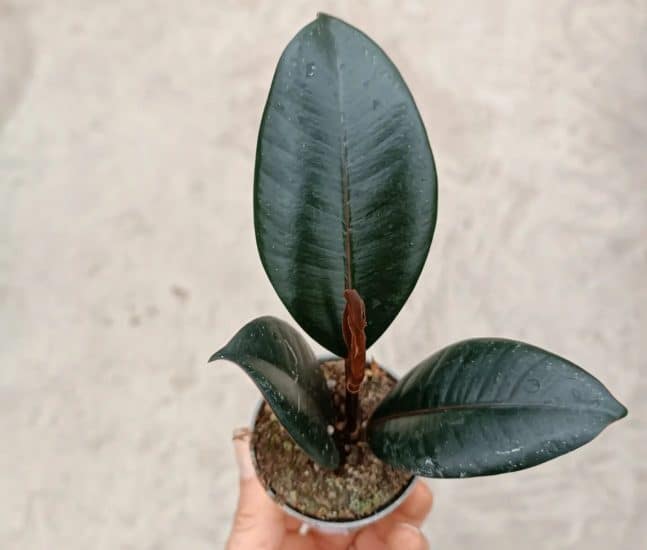
Ficus elastica ‘Robusta’ – Extremely robust, as the name suggests, this is our recommendation for any beginners starting off with their first rubber plant. It’s very easy to care for – a strong plant that is quite resilient in a variety of conditions.
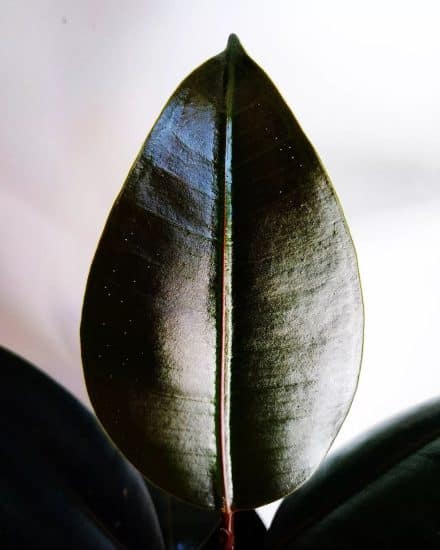
Ficus elastica ‘Abidjan’ – The main difference is coloration – quite a bit darker, more purplish-reddish-color on the veins of the leaves, as well as underneath. Completely different color palette than the Robusta.
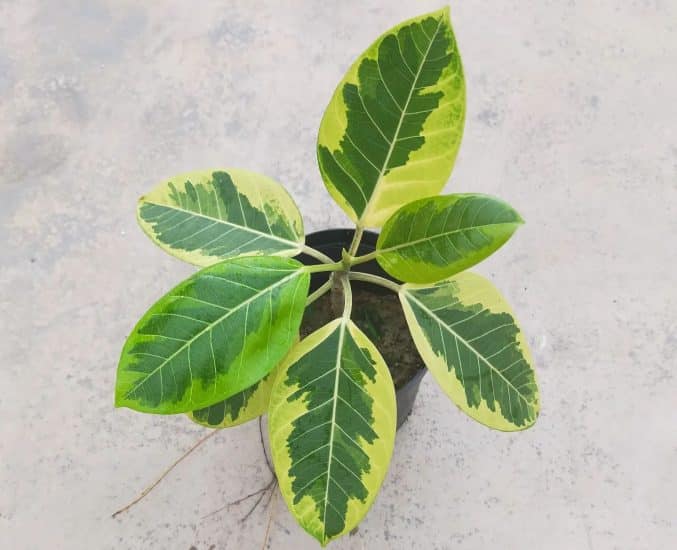
Ficus elastica ‘Lemon N Lime’: There’s actually quite a bit of variety in this variegated Rubber tree. Some appear almost completely yellow with a single note of green, and others really show you quite a range, from yellows to dark greens. This variety loves a lot of light; just be careful with keeping it in direct sun for too long.
Light
Rubber plant care starts with the one factor that often seems just out of our control: how much light we have available.
Rubber plants really prefer a lot of indirect sunlight, but can be placed almost anywhere in your house.
If you search on the internet, you’re going to see “a lot of indirect sunlight, never in direct sunlight because the leaves will burn.” It seems that almost every article about every plant repeats this advice, no matter if it’s true or not.
This isn’t my experience with rubber plants. In fact, they actually like a little bit of direct sunlight during the day. So, maybe not directly next to a south-facing window, where it gets a lot of direct sunlight throughout the day, but a little bit each day is totally fine for rubber fig.
On the other hand, you can also place this plant somewhere a little bit darker, especially Robusta, and it won’t react or complain until the light gets quite dim.
The more variegated Ficus elastica plants do need lots of very bright indirect light and sunlight, or they will lose their variegated forms. They’ll survive, but they will look very different and not like the plant you acquired.
Too much direct light and you’ll notice the leaves burning/scorching, losing their color, and becoming faded and brown. If your leaf edges are brittle and curling, it’s time to add a sheer curtain or move your rubber plant away from the window.
Not enough light will result in variegation turning completely green, slow, leggy growth, and a plant that’s really reaching out and turning its leaves toward whatever bright light it can find. More light and you’ll see that variegation restore and growth speed up.
Tip: Consider turning your plant weekly to really ensure even growth.
Water
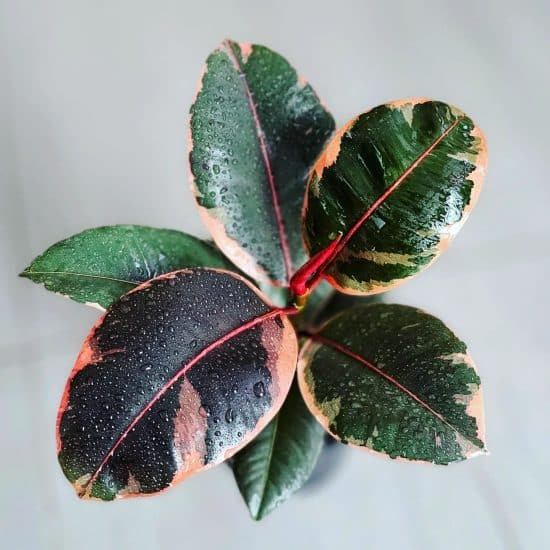
Rubber plants prefer quite a lot of water, so make sure that when you water your Ficus, all of the soil gets a good soak.
You want to pour a lot of water through its pot, making sure it all drains out through drainage holes, the small holes at the bottom of a pot.
This plant does not like to sit in standing water, so make sure the excess water is allowed to drain away. If you use a secondary outer pot for decoration, make sure the water isn’t pooling in this one either.
After watering, you’re going to wait… and wait… and wait until the topsoil of your plant is dry two inches down. If you poke a finger in and feel that it’s dry/warm, it’s time to soak the soil again, repeating the same process as above. We really want the soil dry before watering again.
Especially during periods of fast growth, this plant will pretty efficiently drink the water up through its roots, so try to keep up!
Most people will advise using filtered water, but I’ve had no issues with my tap water. If you do notice leaves dying off at the edges, this could be the plant pushing excess minerals through its leaves and out of the plant. Try switching water sources and make sure any water used is at room temperature.
Overwatering can cause root rot, and you’ll notice the leaves turning yellow. Make sure to let the soil dry out a bit, just the top inch or two.
Underwatering will create dry leaves which curl up and fall off. You’ll notice this even in the younger leaves at the top of the plant. Some leaf drop with mature, older leaves (the leaves closest to the soil) is totally normal.
Temperature and humidity
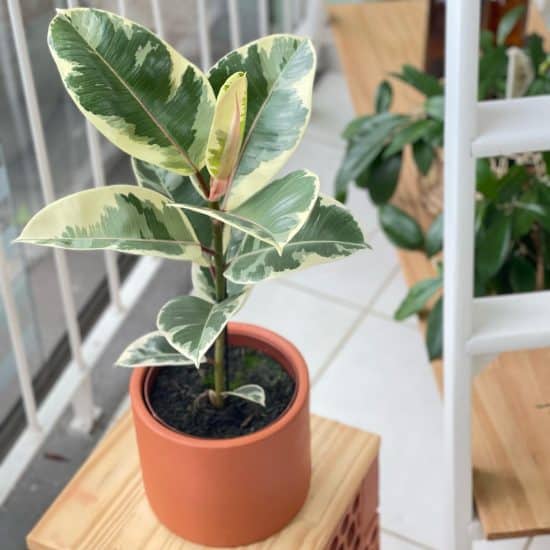
Rubber plants love moisture and thrive in temperatures and humidity levels that mimic their native, tropical environment. These houseplants can withstand some fluctuations and occasional drafts, although consistency is key to their health and vitality.
Temperature: Generally, these plants thrive between 65-80 Fahrenheit. Temperatures below 55 degrees can cause a lot of stress, so even be careful when bringing this plant home if it’s cold out. You’ll want to avoid drafts or placing this plant directly next to a radiator.
Humidity: The ideal humidity level for Ficus elastica plants is pretty close to the normal household range, but on the higher side, around 40-60%. High humidity will really increase the rate of growth and helps a lot with the propagation of new plants.
If you’re having trouble hitting this humidity range, you can:
- Place a small humidifier nearby
- Set up a shallow tray of pebbles and water – as the water evaporates, it raises the local humidity.
- Cluster plants together, creating a microclimate for them
- Place your plant close to a wall or away from heat sources that might dry it out.
Avoid misting this plant without wiping down the leaves after, as this can attract some pests and promote fungal growth.
Soil and planting
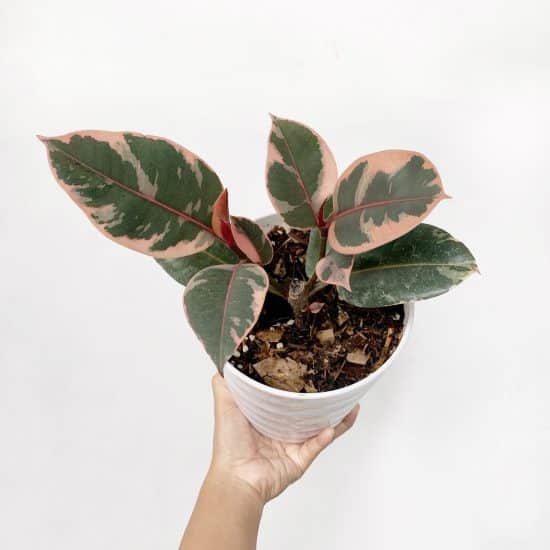
Rubber plants grow best in well-aerated soil that drains quickly. This plant loves water, so we want a mix that will both drain and retain enough moisture so that its roots have a chance to take it up.
Our suggested soil:
- Potting soil (50%)
- Perlite (25%)
- Orchid bark (25%)
Fertilizer can be used throughout the year as you see growth, and likely won’t be needed in the winter unless you are still giving this plant lots of light and humidity.
Fertilize with a diluted balanced liquid fertilizer (that’s a mouthful) monthly when you do use it. Too much fertilizer will look a lot like the effects of poor tap water, with wilting/scorched leaves. If you notice this, you should cut back and flush the soil out with water thoroughly.
Pruning
Don’t be afraid to prune your Ficus elastica. Some ficus can be difficult to prune, but the rubber plant can be pruned almost all year round. I don’t really recommend it during winter, however, because that’s when the Rubber plant grows more slowly.
By pruning, you’re activating the dormant nodes all throughout the same stem. If you look closely, you’ll notice little buds where it will branch out from.
As you prune, you’re not only immediately giving your plant a bushier look, you’re encouraging the plant to grow on these inactive nodes. So prune in the growing season and watch it branch out and become fuller.
Always consider, when you’re pruning a Rubber plant, you’re going to see a white sap that will start to bleed a little bit. This isn’t a problem for your plant, but this white sap can cause allergic reactions, so take care and make sure to use gloves.
If you want, you can wipe the sap off, or let it sit on the cut to help it close over the next few weeks.
That’s it for the first part of our rubber plant care guide. We’ll cover propagation next and then some of the problems that arise.
Propagation guide
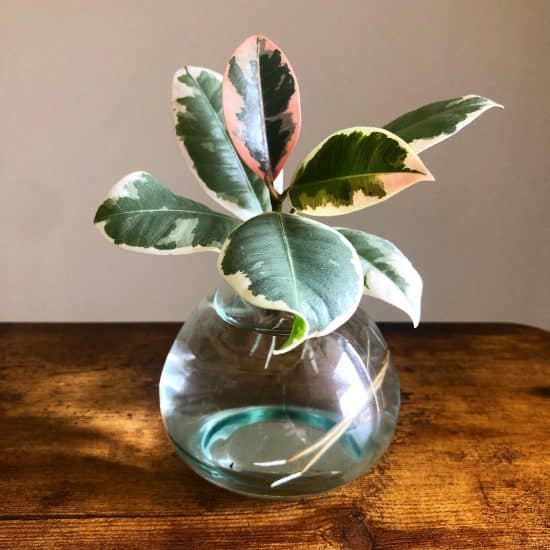
Most people won’t really ever want to propagate their rubber plants because they already take up a lot of room, but if you have a friend who might want one or you want to take advantage of the cuttings from pruning, it’s totally possible.
Compared to some other plants, rubber plants are a bit trickier to propagate. They tend to lose leaves during the process and be a bit fussier.
Propagating rubber plants through stem cuttings
You’ll need the following to get started: sterilized pruning shears, a small pot, potting mix, rooting hormone (optional), gloves, and of course, a healthy rubber plant.
- Pick a stem of your Ficus elastica with at least 3 leaves and cut a length of 4-5 inches, cutting right below a node at the bottom.
- Remove any leaves at the bottom of the cutting so they won’t sit in the soil (or water, if you propagate in water).
- Apply rooting hormone (optionally) and put your cutting into the soil, watering it thoroughly.
- Place your cutting in a location with plenty of indirect light and humidity.
- Make sure to water it frequently over the next few weeks
You can raise the humidity by creating a mini terrarium for your baby rubber plant. You can cover it with a clear plastic bag, glass jar, plastic wrap, or plastic 2-liter bottle that’s been cut in half to help trap that humidity.
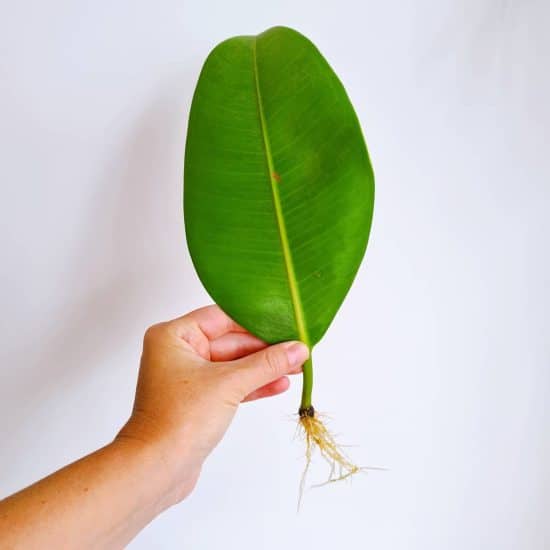
Rooting can take several weeks, so patience is key! As long as you keep the cuttings in the optimal environment, you should soon notice new roots beginning to form. Once the roots are approaching an inch in length, transfer the cutting to a small pot filled with well-draining soil, and your new plant can start to grow.
Common issues

Rubber plants do suffer from a lot of the same issues that most houseplants experience, but fortunately, they’re all well-documented and easy to solve!
(The benefits of owning a popular plant.)
The two Rubber plant problems we see the most often are yellowing leaves and dusty leaves.
Yellowing leaves
If your Rubber plant starts to get yellow leaves, normally it’s the oldest leaves, the leaves lowest and closest to the soil. This means you haven’t watered your rubber tree enough. They’ll actually come off pretty easily.
This plant just needs more water, but don’t only increase the quantity. You instead want to increase the watering frequency. When you replant, a soil change might be in order for soil that retains a bit more water. We want to keep the soil moist, but not so wet that we promote rot.
Dusty leaves
The Rubber plant’s leaves are pretty large, and they tend to accumulate a lot of dust. You’ll want to gently wipe off the leaves with a slightly damp cloth, and you’ll be rewarded with a nice waxy shine.
As an added bonus, if you do this monthly, you’re so close to the plant regularly that you can really check for pests, often found on the underside of a leaf.
So stay intimate with your Ficus, and you’ll avoid needing the advice in our next section!
Diseases and pests
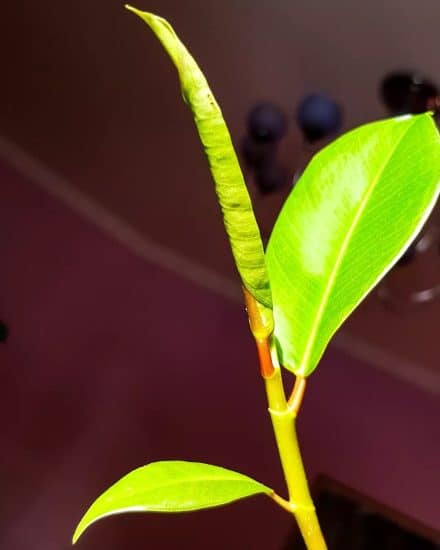
Fortunately, the same sap that annoys us also is pretty annoying for most pests, but a weakened plant can still succumb to an infestation.
We’ll cover the most common pests and diseases Rubber plants experience.
Root rot
Root rot is almost always caused by overwatering your soil, which creates the perfect environment to activate the fungi lying in wait. Overwatered soil tends to compact, killing off the roots and making them food for previously symbiotic fungi.
Root rot almost always manifests as yellowing leaves, weakened stems, and an overall sad-looking plant that droops and stops growing. You’ll want to uproot and inspect. If the roots look dark, mushy, and slimy, you’ll need to cut off any diseased roots and repot in a new pot with new soil.
Make sure that the soil is similar to the mixture we suggest in our soil section, and that your pot has plenty of drainage.
Pests
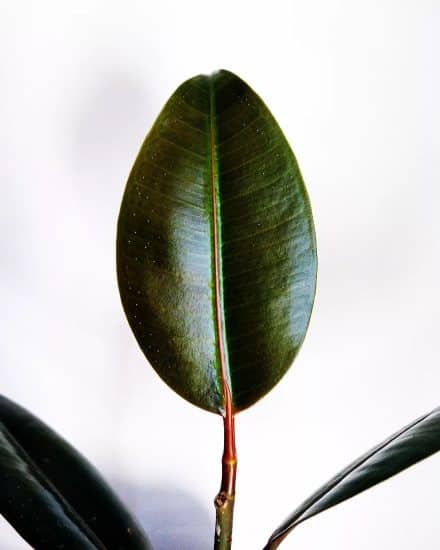
Spider mites and other mites are often hard to see until there are too many. You’ll notice the webbing first, often branching from leaf to stem. You’ll want to spray them off with water (mites hate moisture) and apply neem oil for the next few weeks.
Mealy bugs are small white bugs that often appear as little puffs of cotton, or you’ll notice the sap from your plant. Similarly, you want to remove them, especially from underneath the leaves. A Q-tip or cotton ball in alcohol works great. Apply neem oil for a few weeks to disrupt the eggs and you should be clear.
With any pests, they often are attracted to the younger leaves, and you’ll notice little holes or dark spots in the center of them. A weaker plant is easier for insects to feed on, so really make sure you have your plant care covered.
Conclusion
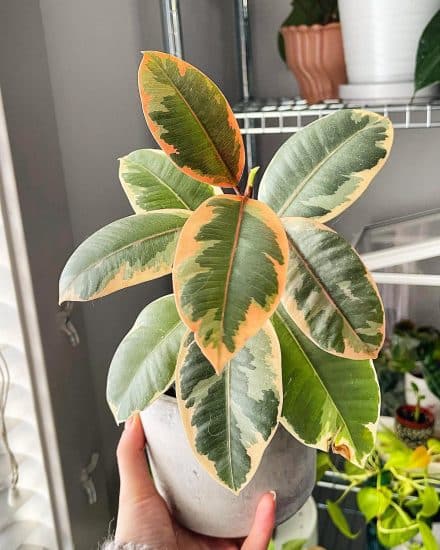
You made it: the end of our rubber plant care guide! You should be feeling pretty confident that you’ll be able to handle any issues you have with these indoor plants. If you still have a lingering question or two, you can jump down to our FAQ.
Quick care summary:
- Some direct light is fine, but too much direct sunlight will result in scorched leaves with brown edges.
- Water frequently as the soil dries, but don’t let your rubber tree’s roots sit in standing water.
- Standard temperature is 65-80 degrees ; avoid cold drafts or drying out next to a radiator.
- Potting mix for your rubber tree should be standard potting soil, perlite, and orchid bark.
- Prune frequently in the growing season to promote a bushier look and encourage new growth along dormant nodes.
If you have any questions we didn’t cover, or want to send in a picture for us to feature, please get in touch, and as always…
Take care!
FAQ
Is there a difference between the Rubber tree and Rubber plant?
Rubber plants and the Rubber tree are both common names for Ficus elastica. Sometimes you’ll see them named differently depending on their size or region, but the care is the same.
Where should I place Rubber plant in my house?
If you want your Rubber plant bushy, you’ll want to place it in an area with lots of light, avoiding direct sun for more than a few hours a day. Pair this with some frequent pruning.
If you’d rather have a leggy look, and if you don’t have a variegated rubber plant, you can decrease the light a bit or even go for a north-facing window.
Are Rubber plants safe for pets?
According to the ASPCA, you should keep pets (like cats and dogs) as well as small children away from this plant, especially when pruning or exposing its sap, as this is an irritant.
Is Ficus elastica good for air?
Rubber plants are fantastic at purifying your air, removing a lot of the most common pollutants you’ll find (NASA specifically tested toluene, xylene, and formaldehyde).
There is some evidence that plants may reduce mold spores from the air as well. Although we haven’t seen any specific testing with rubber plants, we do see this claim repeated without attribution quite often.
How much sun does a Ficus elastica need?
Really, as much as you can give it. The Rubber tree houseplant cannot get enough sun, and they’d probably grow past your ceiling if you let them.

